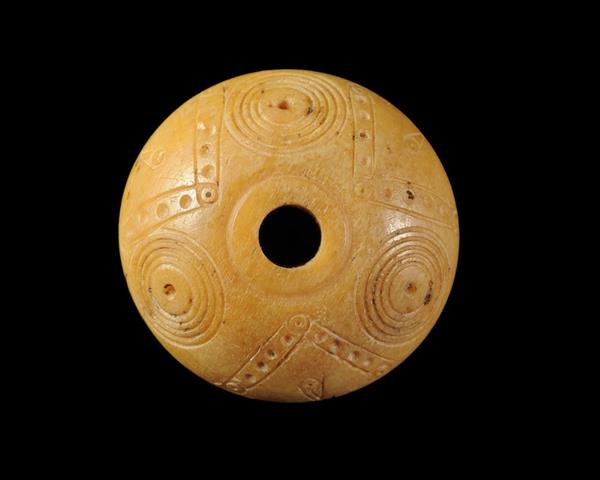
JIAAW, Minassian Collection
Spindle whorls are one of the most common finds in any excavation site or any historical site. They are associated with spinning yarn, a process that takes place after collecting the material and before setting up the loom. Spinning needs a lot of skill and a lot of time. Therefore, in many traditional societies, we see photos of little girls spinning and women spinning while doing other jobs simultaneously. Spinning and weaving are mostly considered women’s jobs, but this is not true for all ancient or traditional societies.
There are many different spinning techniques around the world, but most of them use a spindle. The spindle is used for controlling the twist of the yarn and consists of the spindle shaft, which could be made by a piece of wood or bone, and the spindle whorl. The spindle whorl is important because it sustains the axis of the shaft while spinning. Spindle whorls can tell us a lot about the spinning technique and the type of material that was used.

The JIAAW collection hosts these small objects that attest to spinning in the Early Islamic period (c. 640-900 AD). Probably coming from Iran, these spindle whorls are made of bone and bear incised and painted decoration with motifs that are quite common in early Islam symbolic language.
But, where were they used? These specimens were probably used for the spinning of cotton, which was one of the fibers which people used for the production of textiles during Early Islam. Their use was widespread, following the spread of Islam and the trading networks, from Iran to Spain, and as south as the Arabian Peninsula and Sudan in Africa. Even though there were commonalities, Early Islamic textiles are very different, as they were produced in different places with distinct pre-existing textile traditions.
The most famous Early Islamic textiles are the tiraz. Tiraz are inscribed textiles; they bore names that were embroidered onto them. They were considered the most elaborate textiles and were given as robes to ambassadors as a symbol of their loyalty to the caliphate, or served as a signifier of wealth and status.
We cannot know whether these specimens were used to produce simple cotton cloth or an elaborate tiraz. Whatever the case, they were part of a labor-intensive and skillful process.
-Gerasimoula Ioanna Nikolovieni, Graduate Student, JIAAW
See other examples of spindle whorls and learn more about tiraz textiles:
Tiraz textiles: https://www.metmuseum.org/toah/hd/tira/hd_tira.htm
Spindle whorls: https://www.metmuseum.org/art/collection/search/450033
Islamic textiles: https://sites.lsa.umich.edu/khamseen/short-form-videos/2020/craft-and-aesthetics-in-byzantine-and-early-islamic-textiles/
